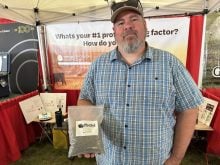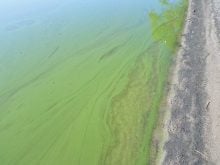If you’re a dry bean grower in Manitoba, you may be spending too much on supplemental nitrogen even when staying within the province’s recommendations, says Kristen MacMillan, a research agronomist for the University of Manitoba’s department of plant science.
A five-site-year study conducted by MacMillan revealed using no nitrogen fertilizer on pinto and navy beans could deliver close to the same yields (86 to 93 per cent of maximum yield) that occur with recommended nitrogen applications.
These zero-nitrogen beans drove a 2,700-pound-per-acre yield while a 70-pound-per-acre nitrogen application (a target within the provincial recommendations) resulted in only 300 more pounds per acre in yield and less than $100 per acre difference in return.
Read Also

Claas brings 1000 Series SP forage harvesters to Canada
In mid-August, Claas unveiled its new line of Jaguar forage harvesters at an event in Visalia, California, deep in the heart of that state’s dairy region.
These findings, which were corroborated by a small-plot survey by Manitoba Pulse and Soybean Growers, could act as a springboard for Manitoba and other provinces to re-evaluate their nitrogen recommendations on dry beans, MacMillan told farmers and industry stakeholders at a virtual session at Ag in Motion 2021. It could also be a wake-up call to the industry to reconsider the role of dry beans as a nitrogen fixer.
“In the literature, and in other regions, dry beans are regarded as a poor nitrogen fixer, and they are, but they still fix nitrogen,” she says, adding they have historically fixed 40 per cent of their nitrogen requirements.
However, the current Manitoba recommendations date back to 2003 — long before the advent of more advanced cultivars and an expanded literature base.
“It was always clear to me that we managed (dry beans) as a non-legume by applying fertilizer and really having no inoculant options,” says MacMillan. “And yet, sometimes, we would see these beautiful nodules. I was wondering what these bean plants are doing and are we perhaps suppressing them by applying nitrogen?”
MacMillan says there will be more investigation into the nitrogen-fixing capacity of specific dry bean cultivars in Manitoba. Recent literature in Western Canada is already showing an average of 26 to 54 per cent of nitrogen requirements being met by fixation in modern cultivars, she says.
In the meantime, what should dry bean growers and agronomists do? Nodule assessment, for starters.
“You may decide this (new data) is enough evidence to adjust your nitrogen strategy. I would encourage you to do this if you already have some knowledge of how beans are behaving in your field — if you can instantly see nodulation, for example,” she says.
“If you’re not already including nodule assessment as part of your regular crop scouting in your dry beans, this is an absolute must in order for you to build knowledge of the specific bean types in your soil environment and to adopt new management strategies going forward.”

But the “cream-of-the-crop” practice would be for farmers to conduct an on-farm trial to discover the nitrogen-fixation specifics of the cultivars they’re using.
“If we’re talking about what would normally be a 70- to 90-pound nitrogen application and you find out you have potential to reduce that by 50 per cent or find that you don’t need supplemental nitrogen at all, that’s a big cost savings and I really think it’s worth the time for you to conduct an on-farm trial.”
Adding nitrogen, a common practice
The amount of supplemental nitrogen used on Manitoba dry bean acres is no small matter.
A survey of 116 dry bean growers in 2016 revealed more than 90 per cent of Manitoba dry bean growers used some amount of supplemental nitrogen. A poll of 114 producers at the same edible bean meeting showed nearly 70 per cent of the respondents applied a rate of 60 to 90 pounds per acre — a number in line with current provincial recommendations for producers seeking a target yield of 2,400 pounds per acre.
“Indeed, farmers are following current guidelines, but please note that these guidelines are from research that is dated to the early 2000s,” says MacMillan.
Dry beans tend to react in very specific ways depending on their environment, underscoring the importance of nodule scouting and on-farm trials.
“There’s a high level of specificity in interactions that occur between the environment, the cultivar, the rhizobia and the nitrogen level in the soil, which makes it really difficult to manage it like other pulse crops,” she says.
As a result, official nitrogen recommendations in other dry bean-growing regions can vary considerably. “Ontario has probably the most contrasting strategy. Their studies recommend no additional nitrogen unless there’s a history of root rot. The recommendation in Saskatchewan, currently, is to apply 50 pounds of nitrogen per acre plus inoculant.”
Nitrogen goes up, nodulation goes down
MacMillan’s study was conducted over three years (2017 to 2019) in two Manitoba locations, Carman and Portage la Prairie. In addition to yield, the study also examined the effect of five nitrogen rates (zero to 140 in multiples of 35) on the nodulation of pinto and navy beans.

The big take-away is as nitrogen rates were increased incrementally nodulation was reduced. For example, plants that received no supplemental nitrogen saw a nodulation score of 0.8, while those that received 140 pounds per acre of nitrogen fertilizer received a score of 0.2.
Although the results do reveal a trend, MacMillan points out the nodulation scores were low overall, both with and without nitrogen fertilizer.
“The scale we were using is zero to four, so we had nodulation but it’s low overall. Our rating in the zero-nitrogen control category was about 0.8 — a rating of one is up to five nodules per plant.
“It takes a lot of energy for a plant to expend on nodule development. If there’s already nitrogen present in the soil, it’s less likely to do that.”
Four emerging guidelines
MacMillan has come up with what she calls four “emerging” guidelines for dry beans — a preliminary summary of what she thinks could become the new nitrogen fertilizer guidelines in Manitoba.
“The first one is probably the most shocking — no supplemental nitrogen and no inoculation,” she says.
“According to the results of our study, you can still expect 86 to 93 per cent of maximum yield without additional nitrogen fertility. This is the optimum economic practice across five site-years of our small-plot studies. That compares with our current recommendation of 60 to 90 pounds of nitrogen, which is a huge reduction.”
For growers who consider zero nitrogen too risky, she recommends a supplemental nitrogen rate of 35 pounds per acre, the second emerging guideline.
“Going by the data, that’s where we’re trying to achieve maximum yield at the lowest rate possible without reducing nodulation.”
Her third recommendation is inoculation, although that may prove unrealistic in the short term. “This isn’t exactly an option now, simply because we don’t have many products available — if any — and testing has just started.”
Her final scenario was a combination of inoculant and supplemental nitrogen. This is also currently unrealistic due in part to the lack of inoculants for dry beans. “And, frankly, we haven’t tested this,” says MacMillan.
















